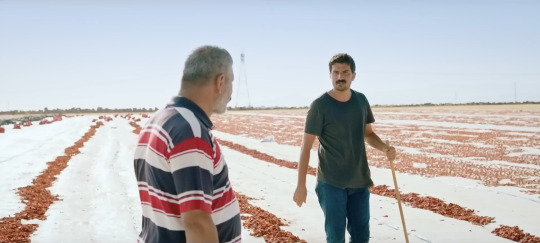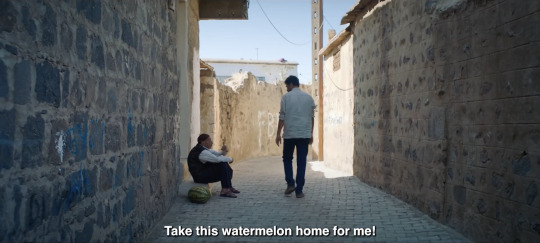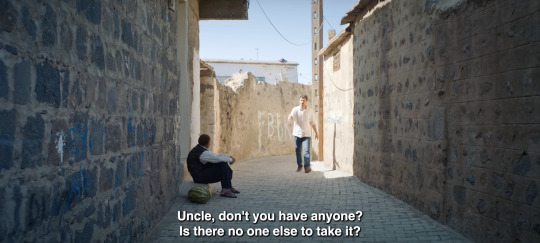#Hemme’nin Öldüğü Günlerden Biri
Explore tagged Tumblr posts
Text
One of Those Days When Hemme Dies (2024) Review
Director: Murat Fıratoğlu
Runtime: 82 minutes
Language(s): Turkish audio; English subtitles
Certification: PG13 (Singapore; some coarse language)

One of Those Days When Hemme Dies feels very much like an adaptation of Abbas Kiarostami’s Where is the Friend’s House?
In Kiarostami’s film, young Ahmad goes on a mission to return a misplaced school notebook to his friend. If this friend doesn’t present his completed homework in the notebook tomorrow, he’ll be expelled. Other than the village, Ahmad doesn’t know where his friend lives. So, he runs around asking others, mostly adults, for help. Nobody manages to provide much of it. Even if they do give some clues as to where his friend might be, Ahmad still ends up wandering through long, winding paths and up and down inclines and slopes. Most frustratingly, the adults barely seem to be listening to him.
In Fıratoğlu’s film, Eyüp (played by Fıratoğlu himself) sets off to shoot his eponymous supervisor, Hemme. Despite repeatedly reminding Hemme about wages, it’s been fifteen days since Eyüp and his fellow tomato harvest workers have received any. One of the workers reminds Eyüp that Hemme is just an employee too, so the wages aren’t in his control, but Eyüp is desperate. He has one last day to repay a debt. I get the sense that unlike Ahmad, Eyüp knows where to go. The issue is about actually getting there.
Eyüp’s motorbike is the first obstacle in getting to Hemme. It keeps dying. So, Eyüp is forced to dismount every so often and run with the bike. He eventually gives up on it, leaving it by the side of a road as the adhan, the Islamic call to prayer, sounds from a distance.
The adhan is a repeating motif throughout the film. In Islam, there are five obligatory daily prayers, and the start of each prayer period is announced with the adhan. These prayers act as reminders of God; as reminders to obey Him. Which entails not taking a life unjustly.
The first time we hear the adhan is during the scene in which he leaves his bike by the side of the road. But before doing this, he pauses, just standing there on barren land, framed in an extreme wide shot. (This is one of the film’s many long takes.) Though we never see Eyüp pray, I like to think that hearing the adhan still gave him pause.
The people that Eyüp meets along his journey is the second obstacle in getting to Hemme. However, Eyüp’s situation is almost the opposite to Ahmad’s in Friend’s House. While Ahmad is usually treated coldly or harshly—especially by adults he knows—Eyüp is often smothered with hospitality, not only by acquaintances but strangers too.

Over and over again, Eyüp is invited to join others: for a meal, for a snack, for some conversation. Over and over again, he insists that he’s “late for work” (is he actually?) but somewhat gives in to their hospitable demands in the end. When an elderly man sitting in an alley asks for help with carrying a watermelon back home, Eyüp keeps walking on at first—then returns, unable to ignore the request. The two then shuffle on to the old man’s house with the heavy fruit and linked arms. At the house, the old man insists that Eyüp have some watermelon.
The sequence with the old man strikes me as the most reminiscent of Friend’s House, which also contains a sequence featuring an old man winding through alleys with the protagonist.

With respect to mise en scène, both sequences use wide shots containing leading lines formed by the sandy-hued walls of the winding alleys. With respect to narrative technique, both use the event of accompanying the old man to build tension. Naturally, he can’t walk fast, so the protagonist must slow down despite the urge to race ahead.
And sure enough, Semih Yıldız mentions Kiarostami in IndieWire’s survey of cinematographers with films screening at the Venice Film Festival 2024: “When I first read Murat Fıratoğlu’s script […], the world in which the story takes place reminded me of the minimal cinematic language of Abbas Kiarostami”.
However, the tension that builds in One of Those Days feels more comedic than in Friend’s House. For someone who seems quite determined to shoot a person, it’s ironic that Eyüp can’t bring himself to be impolite to others. It’s somewhat absurd. So, the tension in Fıratoğlu’s film was enjoyable while it was frustrating in Kiarostami’s.
One of Those Days When Hemme Dies feels very much like an adaptation of Abbas Kiarostami’s Where is the Friend’s House?: a Turkish, more adult, and more entertaining adaptation.
Rating: 4/5
Thank you to SGIFF for the Cinephile Pass and for the screening of One of Those Days When Hemme Dies.
#film review#movie review#film criticism#sgiff#sgiff35#35th singapore international film festival#turkish cinema#drama#Murat Fıratoğlu#abbas kiarostami#عباس کیارستمی#where is the friend's house?#one of those days when hemme dies#Hemme’nin Öldüğü Günlerden Biri#turkish film
2 notes
·
View notes
Text

Um daqueles dias em que Hemme morre (Hemme’nin öldüğü günlerden biri), de Murat Fıratoğlu (Turquia, 2024)
0 notes